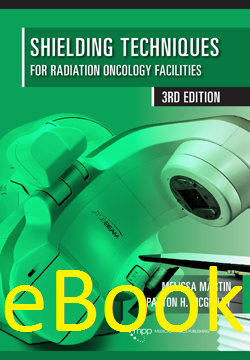
Shielding Techniques for Radiation Oncology Facilities, 3rd Edition, eBook
Author: Melissa Martin and Patton H. McGinleyISBN: 9781951134013
Published: July 2020 | 170 pp | eBook
Price: $ 100.00
Medical Physics International | 10/2020
Since the second edition of this book by Patton McGinley was published in 2002, NCRP Report No. 151 appeared in 2005 to supersede Report No. 49. That report was an up-to-date review of the field of radiation shielding, including data from Report Nos. 49, 51 and 79. Importantly, more data relevant to calculations was included, as well as, for the first time, a section on explicit calculations for typical primary and secondary barriers. A new edition of McGinley’s book, now co-authored by Melissa Martin, has recently been published. This edition is a significant update to the last version as well as to NCRP Report No. 151 and the authors are to be commended for the advances this tome makes to the field.
A major, and welcome, addition to this edition is the enlargement of the special topics section to include radiation therapy modalities that are new to the market since the previous publication, including Cyberknife® and Tomotherapy® (even NCRP Report No. 151 barely covers these topics) and other ring-mounted gantry systems. This is important since, for these machines, the target to isocenter distance is no longer 1m so the workloads at isocenter have to be adjusted accordingly; the calculations provided are a great help in this regard. In particular, the section on the Elekta Unity® is very detailed and a great help to a designer to avoid calculational pitfalls. Finally, skyshine and side scatter is also covered in considerably more detail than in the previous edition.
One major improvement appears in this version, namely doors, both with and without mazes. The section on doors at the end of a maze for low energy beams has been expanded to consider alternative maze designs. The section on mazes and doors for high energy rooms (now the norm) includes more detail on direct shielded doors and, importantly, calculations detail the case for three energy machines that are now becoming more common in the field (this is important because the ‘extra HVL’ recommendation for handling combined leakage and scatter, which was, in any case, difficult to apply for dual energy machines, is virtually impossible for three energy machines). Experienced room designers recognize that primary and secondary barrier calculations are easily handled by spreadsheets, but direct shielded doors for high energy rooms and also HVAC ducts require ray tracing and hand calculations, which are both time-consuming and tedious. What makes this section so useful, in light of this, is the detailed practical considerations that usually only come with experience and should be welcomed by the novice.
The treatment of x-ray simulators has been deleted, appropriately, since most departments routinely use CTs for simulation. A brief section on CT simulators would have been useful, however, since, although NCRP Report No. 147 describes CT dosimetry in detail, CT workloads in radiation therapy can be quite different from diagnostic radiology, e.g., 4D CT. While the leakage TVL for forward radiation is correctly noted to be 5.7, the leakage radiation at 90° for the barriers not in the gantry plane is not identified as 4.5 cm as given in the 2nd edition.
Placement of all the tables in an appendix is a sensible move to allow a designer to look up a parameter more readily. The notations in the previous edition of “nSv/s” and “cSv/wk” for dose equivalent and “6.67 cGy/s” for dose rate have been changed to conventional units. There are a few errata to be noted: Figs. 4-3 and 5-13 are missing and equation 5-9 is lacking a divisor. Interestingly, new vocabulary has entered the field: gantries and collimators are no longer ‘rotated’ but ‘clocked.’ An unresolved issue remains as to how to determine TVLs for high density concrete, given that the NCRP reports the first and additional TVLs separately for primary and leakage radiation, while vendors use only one TVL for primary beams and one TVL for both leakage and scatter.
This book adds extra value to the previous addition and NCRP Report No. 151 in areas that, as noted above, were described, but lacked sufficient detail to aid the shielding designer in their calculations; this edition corrects that deficiency. This book is destined to be a standard reference book for all medical physics undergraduate, graduate and residency programs. In summary, this book is a welcome addition to radiation therapy bibliography and should be on the bookshelf of every medical physicist.
Peter J. Biggs Ph.D.,
Formerly Associate Professor,
Department of Radiation Oncology,
Massachusetts General Hospital,
Harvard Medical School,
Longboat Key, FL


